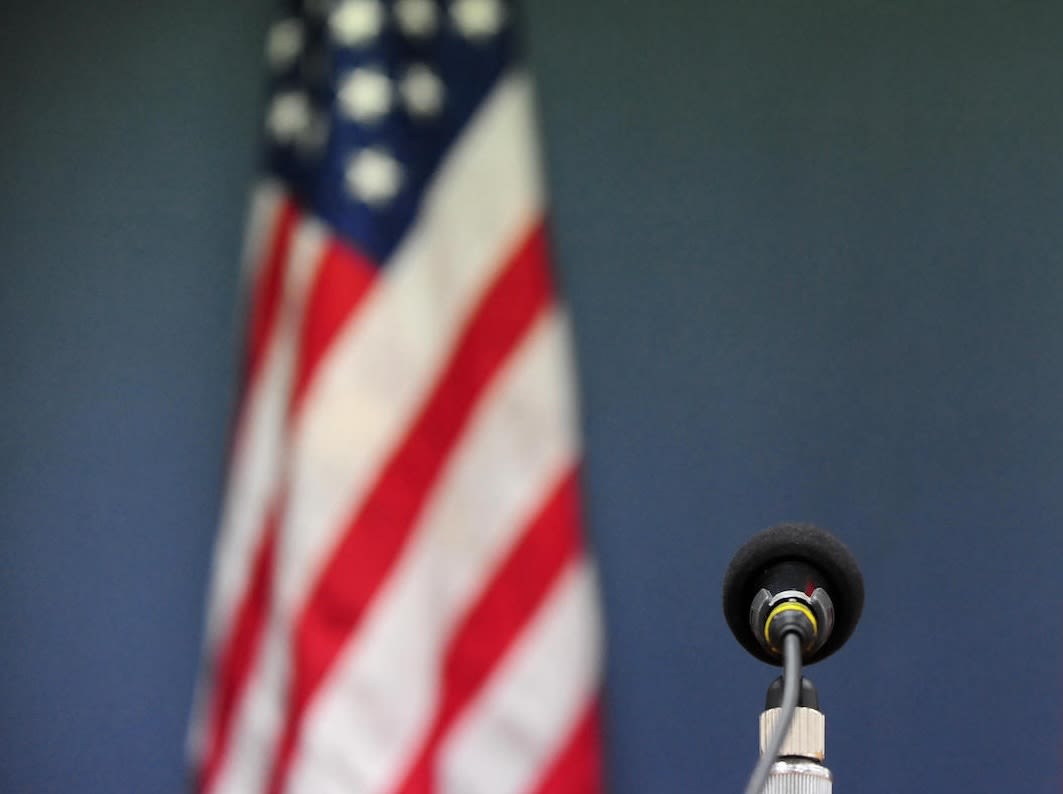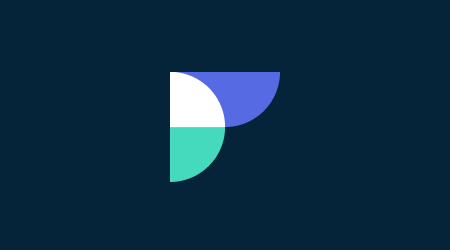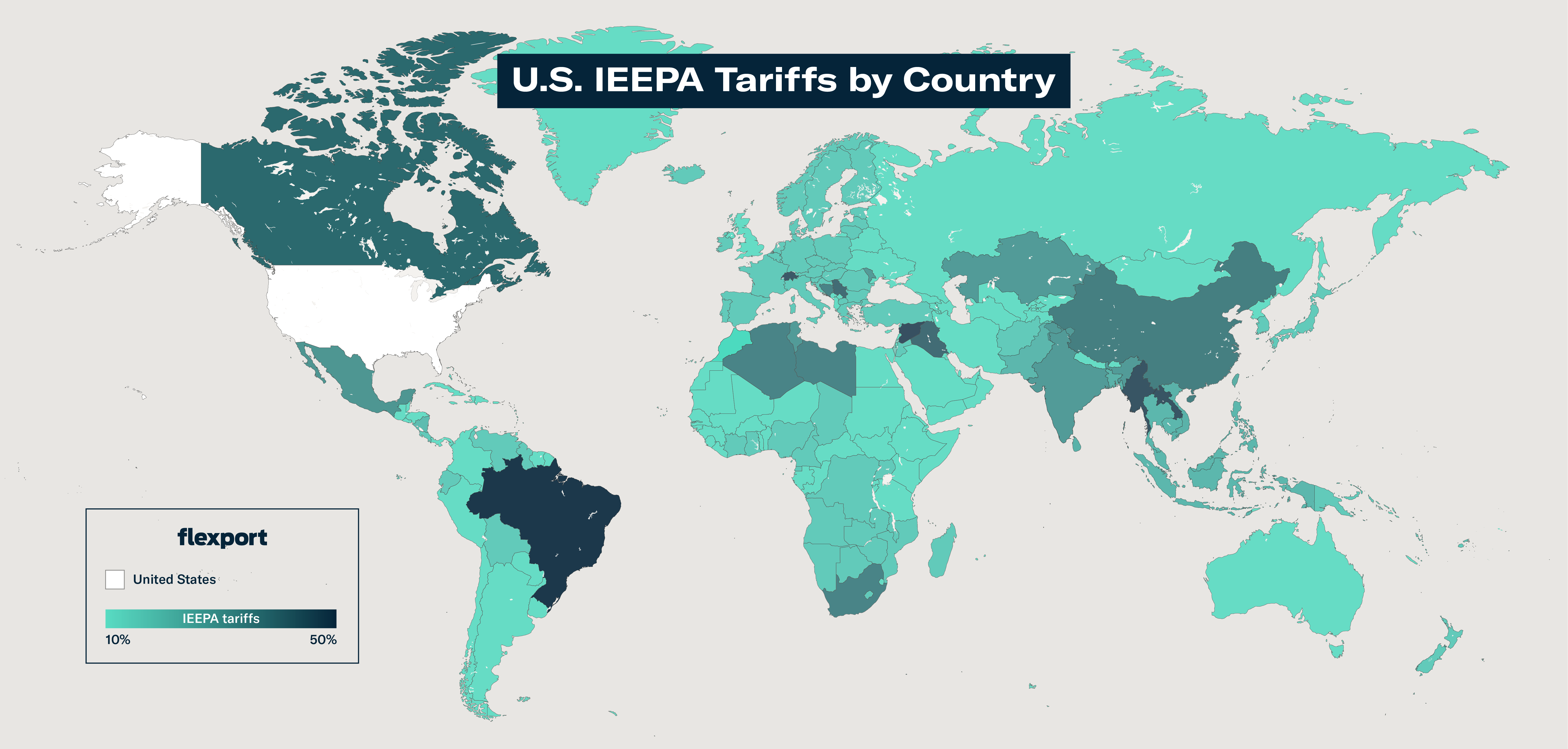
March 28, 2025
Early Updates on the Trump Administration’s Tariff and Trade Policies, Part III
Tags:

March 28, 2025
This page contains Flexport’s older updates (late June - early August) on the Trump administration’s tariffs and trade policies. Find early updates from mid-March - mid-June here, and even older updates (including our original blog on the 2024 election) here.
For Flexport’s most up-to-date developments and guidance, check out our live tariff and trade blog.
Calculate and analyze tariff impacts in real time with the Flexport Tariff Simulator.
Updated August 5, 2025:
Yesterday, the EU announced that it plans to delay its countermeasures against U.S. tariffs for six months. These countermeasures, which included tariffs of up to 30% on a range of U.S. goods, were originally set to be implemented on August 7, 2025.
The announcement comes just over a week after the U.S. and the EU announced a preliminary trade agreement, under which most EU goods would face a 15% tariff.
Separately, President Trump indicated today that he may announce tariffs on semiconductors and pharmaceuticals as soon as next week. The U.S. Department of Commerce commenced its Section 232 investigation into semiconductors in April, and is expected to release results early this month.
As for pharmaceuticals, President Trump told CNBC that tariffs will be “initially small,” but “in one year—one and a half years, maximum—it’s going to go to 150%, and then it’s going to go to 250%.”
Finally, in an August 4 Truth Social post, President Trump stated he intends to “substantially [raise] the tariff paid by India to the U.S.,” given India’s ongoing purchases of “massive amounts of Russian oil.” Per last week’s executive order, India is currently set to face a 25% reciprocal tariff on August 7.
Updated August 1, 2025:

Last night, on July 31, President Trump published an executive order modifying tariffs on Canada:
- The tariff rate on Canadian imports to the U.S. has increased from 25% to 35%, effective August 1 at 12:01 a.m. ET.
- Exemptions for goods compliant with the United States-Mexico-Canada Agreement (USMCA) remain unchanged.
- The current tariff stacking order also remains unchanged.
- Goods determined to have been transshipped to evade duties will be subject to a tariff rate of 40% in lieu of the 35%, along with applicable fines or penalties.
President Trump also published an executive order last night detailing modified reciprocal tariff rates for nearly 70 trade partners, set to take effect on August 7 at 12:01 a.m. ET.
- Any nation not listed in the executive order will be subject to a 10% baseline reciprocal tariff (with the exception of China and Canada).
- Goods determined to have been transshipped to evade duties will be subject to a 40% tariff.
- To qualify for the reciprocal in-transit exception, goods must be loaded onto a vessel at the port of loading and in transit on their final mode of transportation before August 7 at 12:01 a.m. ET, and arrive before October 5 at 12:01 a.m. ET.
- EU goods: Imports with an HTSUS Column 1 duty rate of 15% or higher will face a 0% tariff. Meanwhile, imports with a Column 1 duty rate of less than 15% will face a tariff determined as follows: 15% minus the Column 1 duty rate.
Per the order, upcoming reciprocal tariff rates are as follows:
| Trade Partner | Adjusted Reciprocal Tariff |
|---|---|
| Afghanistan | 15% |
| Algeria | 30% |
| Angola | 15% |
| Bangladesh | 20% |
| Bolivia | 15% |
| Bosnia | 30% |
| Botswana | 15% |
| Brazil | 10% |
| Brunei | 25% |
| Cambodia | 19% |
| Cameroon | 15% |
| Chad | 15% |
| Costa Rica | 15% |
| Côte d'Ivoire | 15% |
| Democratic Republic of the Congo | 15% |
| Ecuador | 15% |
| Equatorial Guinea | 15% |
| EU: Goods with ≥ 15% Column 1 duty rate | 0% |
| EU: Goods with < 15% Column 1 duty rate | 15% minus Column 1 duty rate |
| Falkland Islands | 10% |
| Fiji | 15% |
| Ghana | 15% |
| Guyana | 15% |
| Iceland | 15% |
| India | 25% |
| Indonesia | 19% |
| Iraq | 35% |
| Israel | 15% |
| Japan | 15% |
| Jordan | 15% |
| Kazakhstan | 25% |
| Laos | 40% |
| Lesotho | 15% |
| Libya | 30% |
| Liechtenstein | 15% |
| Madagascar | 15% |
| Malawi | 15% |
| Malaysia | 19% |
| Mauritius | 15% |
| Moldova | 25% |
| Mozambique | 15% |
| Myanmar | 40% |
| Namibia | 15% |
| Nauru | 15% |
| New Zealand | 15% |
| Nicaragua | 18% |
| Nigeria | 15% |
| North Macedonia | 15% |
| Norway | 15% |
| Pakistan | 19% |
| Papua New Guinea | 15% |
| Philippines | 19% |
| Serbia | 35% |
| South Africa | 30% |
| South Korea | 15% |
| Sri Lanka | 20% |
| Switzerland | 39% |
| Syria | 41% |
| Taiwan | 20% |
| Thailand | 19% |
| Trinidad and Tobago | 15% |
| Tunisia | 25% |
| Turkey | 15% |
| Uganda | 15% |
| United Kingdom | 10% |
| Vanuatu | 15% |
| Venezuela | 15% |
| Vietnam | 20% |
| Zambia | 15% |
| Zimbabwe | 15% |
Updated July 30, 2025:
Today, President Trump signed an executive order that will suspend the de minimis exemption for low-value shipments (i.e., valued at or under $800) beginning August 29, 2025, for all countries of origin.
- For low-value goods shipped via the international postal system: For the first six months following the August 29 implementation date, these goods will face a duty ranging from $80 to $200 per item, depending on the IEEPA tariff rate that applies to the product’s country of origin. After six months, all low-value shipments will be subject to the ad valorem IEEPA tariff applicable to the product’s country of origin, without any minimum or maximum duty per item.
- For low-value goods shipped through means other than the international postal system: These goods will be subject to all applicable duties.
- American travelers will still be able to bring up to $200 in personal items back to the U.S. duty-free, and Americans can continue to receive up to $100 in bona fide gifts duty-free.
The U.S. previously ended de minimis treatment for Chinese-origin goods on May 2, 2025. Additionally, earlier this month, President Trump signed the One Big Beautiful Bill Act (OBBBA), which will permanently repeal the statutory basis for the de minimis exemption on July 1, 2027. Today’s executive order will suspend de minimis treatment “more quickly than the OBBBA requires … to save American lives and businesses now.”
President Trump also signed an executive order today that will increase tariffs on Brazilian imports by 40%, bringing the total effective duty rate on Brazil to 50%.
- The new tariff rate will take effect seven days from today—i.e., on August 6, 2025.
- Goods loaded onto a vessel and in transit on their final mode of transit before August 6 and “entered for consumption, or withdrawn from warehouse for consumption” before October 5, 2025, will be exempted from the new duty rate. These goods will remain subject to the current 10% tariff rate.
Additionally, President Trump also signed a proclamation today on new copper tariffs, which he had originally announced on July 9.
- Effective August 1, semi-finished copper products and copper-intensive derivative products will face a 50% Section 232 tariff.
- The copper tariff will apply to products’ copper content, while non-copper content will remain subject to reciprocal tariffs or other applicable duties. These tariffs will not stack.
- Section 232 auto tariffs and copper tariffs will not stack. Products subject to auto tariffs will be exempt from copper tariffs.
President Trump also announced on Truth Social today that the U.S. will impose a 25% tariff on India, effective August 1. India will also face an unspecified penalty for buying military equipment and energy products from Russia.
Finally, the latest round of U.S.-China trade negotiations concluded on July 29—just two weeks before the nations’ August 12 deadline for finalizing a trade deal. U.S. and Chinese officials have agreed to push for an extension of the temporary 90-day agreement that took effect in May, though U.S. Treasury Secretary Scott Bessent indicated that the final decision would lie with President Trump.
Updated July 28, 2025:
Yesterday (July 27), the U.S. and the EU reached a preliminary trade agreement. Terms are as follows:
- The U.S. will impose a 15% tariff on EU imports, including pharmaceuticals, automobiles, and semiconductors.
- The EU will purchase $750 billion in U.S. energy products and invest an additional $600 billion in the U.S., all by 2028.
- The EU will work with the U.S. to eliminate various tariffs, and will establish quotas for certain products.
- The EU will work with the U.S. to address certain non-tariff barriers, including those related to digital trade and U.S. agricultural exports. In particular, the EU will not implement or maintain any network usage fees, and will streamline requirements for sanitary certificates for U.S. pork and dairy products.
- The EU will eliminate “red tape” and “burdensome” requirements that U.S. exporters face when conducting business in the EU.
- The EU will purchase significant amounts of U.S. military equipment.
- As of now, the EU will continue to face 50% sectoral tariffs on steel, aluminum, and copper.
It remains unclear when this agreement will take effect. Additionally, the deal has not yet been finalized, and may be subject to change.
Separately, the U.S. is expected to announce the results of a Section 232 investigation into semiconductors in about two weeks—meaning chip imports could potentially face new levies.
Finally, U.S.-China trade talks will resume today—just over two weeks ahead of August 12, the deadline for the two nations to finalize a trade agreement. U.S. Treasury Secretary Scott Bessent indicated last week that “we’ll be working out what is likely an extension,” referring to the temporary 90-day agreement that took effect in May.
Updated July 23, 2025:
Yesterday, President Trump announced on Truth Social that the U.S. and Japan had reached a trade deal. Per the agreement, Japan will face a 15% reciprocal tariff; invest $550 billion into the United States, which will receive 90% of profits; and “open their country to trade, including cars and trucks, rice, and certain other agricultural products.”
Japan is the U.S.’s fifth-largest trade partner, with the U.S. importing $148.2 billion in Japanese goods in 2024 alone. More than a third of those imports consisted of automobiles and auto parts, according to the International Trade Administration.
Updated July 16, 2025:
On July 7, President Trump began publishing his first batch of tariff letters laying out trade agreement terms with select nations. These include proposed reciprocal tariff rates—all expected to take effect on August 1, 2025, pending official confirmation via executive order or Federal Register notice.
Duties proposed so far include:
| Nation | Proposed Reciprocal Tariff |
|---|---|
| Japan | 15% |
| Indonesia | 19% |
| Philippines | 19% |
| Vietnam | 20% |
| Brunei | 25% |
| India | 25% |
| Kazakhstan | 25% |
| Malaysia | 25% |
| Moldova | 25% |
| South Korea | 25% |
| Tunisia | 25% |
| Algeria | 30% |
| Bosnia | 30% |
| European Union | 15% |
| Iraq | 30% |
| Libya | 30% |
| Mexico | 30% |
| South Africa | 30% |
| Sri Lanka | 30% |
| Bangladesh | 35% |
| Canada | 35% |
| Serbia | 35% |
| Cambodia | 36% |
| Thailand | 36% |
| Laos | 40% |
| Myanmar | 40% |
| Brazil | 50% |
Per the letters, if any of the aforementioned nations raises tariffs on the U.S., then the U.S. will increase its reciprocal tariff on that nation by an identical amount. Additionally, any goods that are transshipped to evade a higher tariff will be subject to that higher tariff.
The original end date for the Trump administration’s 90-day country-specific reciprocal tariff pause was July 9, 2025. Per President Trump’s executive order published July 7, that end date has been postponed to August 1, 2025.
Separately, President Trump announced on July 9 that a 50% tariff on copper imports will take effect on August 1, now that the Commerce Department’s national security investigation into copper has concluded.
President Trump stated that he also plans to impose pharmaceutical tariffs as high as 200%—but will first “give people about a year, a year and a half, to [bring manufacturing operations to the U.S.].”
Finally, on July 6, President Trump announced on Truth Social that he intends to levy an additional 10% tariff on “any country participating in the anti-American policies of BRICS,” with “no exceptions to this policy.”
Prior to President Trump’s announcement, BRICS—an intergovernmental group that includes Brazil, Russia, India, China, South Africa, Egypt, Ethiopia, Indonesia, Iran, and the UAE—released a statement expressing “serious concerns” about unilateral tariffs that “are inconsistent with WTO rules.” BRICS’ statement did not explicitly mention the Trump administration or the United States.
Updated July 7, 2025:
Today, the White House published an executive order postponing the end date for the country-specific reciprocal tariff pause to August 1, 2025. Until then, reciprocal tariffs will remain at their current rates.
Updated July 4, 2025:
The Big Beautiful Bill: A New Chapter in Global Trade
The "Big Beautiful Bill,” represents a significant shift in international trade policy. This legislation aims to rebalance global trade relationships through a combination of targeted tariffs, enhanced supply chain security provisions, and investment in domestic manufacturing capabilities. The bill seeks to address economic concerns through a two-pronged approach: reforming business taxation to incentivize domestic job creation while implementing stronger immigration enforcement measures. For global markets, this signals a move away from unrestricted free trade toward a more managed approach that prioritizes national economic interests and supply chain resilience. While supporters argue it will revitalize domestic industries and create jobs, critics warn that the bill could stifle economic growth by increasing costs for businesses through stricter compliance requirements while potentially exacerbating labor shortages in key industries that rely on immigrant workers. As implementation begins, businesses worldwide are reassessing their international strategies to navigate this evolving trade landscape.
With the passing of the Big Beautiful Bill, many ‘Big’ changes have been made but let’s discuss one in particular…
SEC. 70531 - End of De Minimis
This portion of the bill clarifies that this is for commercial de minimis only. SEC. 70531 of the bill creates a new penalty that is effective in 30 days from enactment. If an importer tries to claim de minimis where they are not otherwise allowed to then a new penalty will be introduced: $5,000 for the first violation and up to $10,000 for each subsequent violation.
Lastly, the Big Beautiful Bill will end De Minimis for all countries on July 1st, 2027 (however, China is still banned from De Minimis today).
Updated July 2, 2025:
President Trump announced on Truth Social a trade agreement between the U.S and the Socialist Republic of Vietnam. Following discussions with To Lam, General Secretary of the Communist Party of Vietnam, the agreement establishes new tariff structures aimed at strengthening economic relations.
The U.S. will apply a 20% tariff on all goods of Vietnamese origin, and a 40% tariff on transshipping activities. As part of the agreement, the U.S. is granted full access to the Vietnamese market, allowing American products to enter Vietnam without any tariffs.
This agreement could significantly impact the export of SUVs and large engine vehicles from the U.S. into Vietnam, expanding the product range available in the Vietnamese market.
A formal announcement, including clarification around the transshipping activities, is still pending.
Updated June 27, 2025:
President Trump stated yesterday that the U.S. had “just signed [a deal] with China,” though it appears that the agreement is unrelated to tariffs. Since then, White House officials have indicated that the deal involves streamlining American access to Chinese rare earth minerals—an essential component of semiconductor manufacturing.
Increasing U.S. access to Chinese rare earth shipments comprised part of the proposed U.S.-China trade agreement President Trump announced earlier this month. However, that agreement—which also includes a 55% tariff rate on China—has yet to be approved by President Trump and President Xi.
Separately, President Trump announced on Truth Social today that the U.S. is “terminating all discussions on trade with Canada, effective immediately,” in light of Canada’s digital services tax on American technology companies. The Trump administration will “let Canada know the tariff that they will be paying to do business with the United States within the next seven-day period,” he added.
The current effective tariff rate on Canada is 25%, excluding energy products (10%) and goods that fall under the United States-Mexico-Canada Agreement (USMCA) (0%).
About the Author

March 28, 2025


